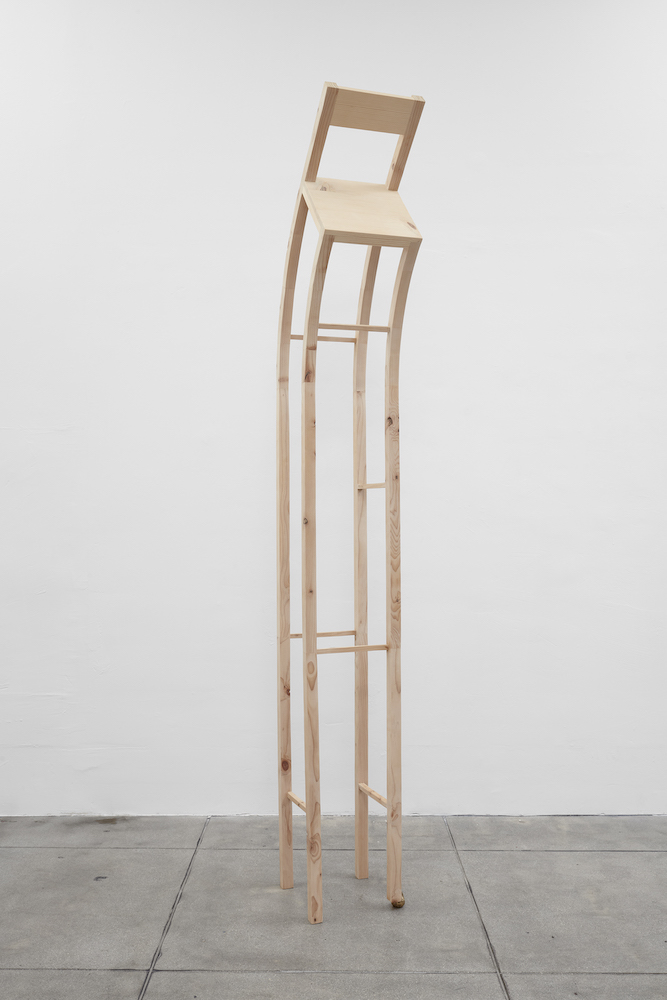Passing through the doors of Carlye Packer brings you face-to-face with Nancy Pelosi. Dressed in a bright blue blazer, mask tight across her face and her right hand grasped around a gavel she has thrust in the air, Pelosi—or rather her likeness—is set center within the mixed media work hung on the entrance wall. Edging in from the bottom and top of the frame are the red and white stripes of flags, and jutting in from the corner is the figure of a woman rendered softly à la classical sculpture. Strewn across the entire piece are brownish blobs, marks that look as though someone soaked a rag in oil and left it on the work’s surface.
The piece, Ross Edward Doyle’s Go East! (2023), is the entry point to the group show “Foundations,” conceived by guest curator Jason Roussos. The exhibition features Doyle, Sharif Farrag, Magdalena Frimkess, Emmanuel Louisnord Desir, Grant Levy-Lucero, Acacia Marable, Serling Ruby and Marley White—a diverse roster of artists of varying backgrounds, materials, career points and themes, yet unified by their respective practices’ nuanced takes on what is “the sculptural.” Although Doyle’s Go East! is a two-dimensional work within an exhibition of three-dimensional art, it ties in seamlessly. Each figure and mark on its surface is translucent, allowing viewers to fall into the depths of Doyle’s piece as they sort through the washed out layers built upon one another, imbuing it with a unique dimensionality. The inclusion of Doyle’s art lends credence to the show being a survey of the multi-faceted ways sculpture is considered and created today.

Ross Edward Doyle, Go East!, 2023. Photo: Evan Walsh. Courtesy of Carlye Packer.
In the corner of the gallery sits White’s sculpture, A father is just a child, he sits at the head of the table (2022). Modeled after the ubiquitous, straight-back kitchen chair (think IKEA), it is transformed into a staggering 8 feet tall with a curved seat, making it impossible to sit on without sliding off onto the cement below. Beneath one of the front legs is a true-to-size bronze fig, delicately crushed on one side as it bears the weight of the chair. White’s work toes the line of utility and sculpture as it mixes the rudimentary and (questionably) functional chair with the “fine art” of casting. The chair’s curved spine gives it the appearance that at any moment the fragile frame could topple over and crash, thus playing with the common (mis)conception of sculptures being sturdy.

Marley White, A father is just a child, he sits at the head of the table, 2022. Photo: Evan Walsh. Courtesy of Carlye Packer.
Hung alone on a wall facing the other objects in the exhibition is Ruby’s fanged mouth soft sculpture, Vampire 125 (2023), swathed in bright orange and camo fabric, mouth agape and with blood-red droplets hanging from the fangs. The sculpture itself is an obvious play on Claes Oldenburg’s infamous inversion of the sculpture medium, but because of its placement in the gallery, you can almost imagine it devouring the other artworks on display—a comical nod to Ruby’s practice of digesting mediums and materials and reworking them.
The other artists in the show play with the medium in similar ways: Desir’s and Marable’s works combine sculpture with play; Farrag, Frimkess and Levy-Lucero use scale, form and iconography to question what is “craft” and what is a “fine art.” The eclecticism of the show works in Rousso’s favor as the artworks—individually and collectively—interrogate what it means to be sculptural, and lay down the beginnings of a new foundation for the medium.

